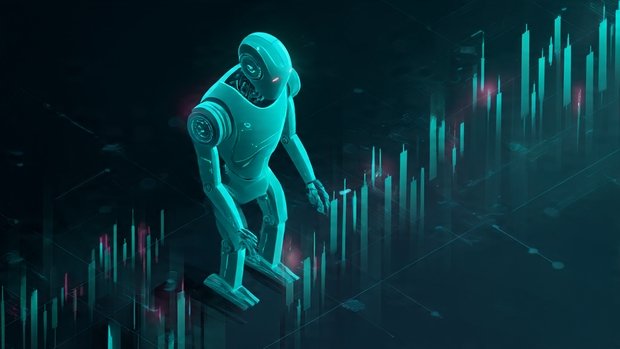Cryptocurrency and AI Trading Opportunities and Risks
Explore cryptocurrency and AI trading opportunities, risks, automated bots, machine learning strategies, and how artificial intelligence transforms.

The convergence of cryptocurrency and artificial intelligence has revolutionized the digital asset trading landscape, creating unprecedented opportunities for investors while simultaneously introducing complex challenges. As AI trading bots become increasingly sophisticated, they’re reshaping how traders interact with volatile crypto markets, offering 24/7 automated execution and data-driven decision-making capabilities that were unimaginable just a few years ago. Recent studies indicate that algorithmic trading now accounts for approximately 60-75% of trading volume in major financial markets, with a significant portion of cryptocurrency trading also driven by automated systems.
Machine learning algorithms have transformed traditional trading approaches by analyzing vast amounts of market data, identifying patterns, and adapting strategies in real-time to optimize performance. These AI-powered trading systems can process information at lightning speed, execute trades within milliseconds, and operate continuously without the emotional biases that often plague human traders. However, this technological revolution isn’t without its pitfalls—from cybersecurity vulnerabilities and market manipulation risks to regulatory uncertainties and the potential for catastrophic losses due to algorithmic failures.
As the crypto trading ecosystem evolves, both the transformative potential and inherent dangers of AI trading become essential for investors, whether they’re seasoned professionals or newcomers exploring automated trading strategies. The integration of artificial intelligence in cryptocurrency trading represents a paradigm shift that demands careful consideration of risk management, security protocols, and the fundamental limitations of even the most advanced trading bots. This comprehensive guide examines the multifaceted relationship between cryptocurrency and AI trading, providing insights into how these technologies intersect, the opportunities they create, and the critical risks every trader must understand before deploying AI-driven trading solutions in their investment strategy.
AI in Cryptocurrency Trading
Artificial intelligence in cryptocurrency trading refers to the implementation of advanced computational algorithms, machine learning models, and automated systems that analyze market data and execute trades without continuous human intervention. These sophisticated systems leverage multiple AI technologies, including neural networks, predictive analytics, and deep learning, to process enormous datasets and identify profitable trading opportunities.
What Are AI Trading Bots
AI trading bots are automated software programs specifically designed to interact with cryptocurrency exchanges through APIs (Application Programming Interfaces). Unlike traditional pre-programmed algorithms that operate on fixed parameters, AI-powered bots possess the unique ability to learn from new data, adjust their strategies dynamically, and adapt to evolving market conditions. These systems continuously analyze historical price movements, real-time market data, social media sentiment, and numerous technical indicators to make informed trading decisions.
The fundamental difference between conventional algorithmic trading and AI-driven trading lies in adaptability. Traditional bots follow a predetermined script based on backtested strategies, while machine learning-powered systems can independently evolve their approach as market dynamics shift. This adaptive capability makes AI trading bots particularly valuable in the notoriously volatile and unpredictable cryptocurrency markets.
How AI Trading Systems Operate
AI trading systems function through several integrated processes that work together to identify opportunities and execute trades. First, these systems collect and process massive amounts of market data from multiple sources, including price charts, trading volumes, order book data, news feeds, and social media platforms. Machine learning algorithms then analyze this information to detect patterns, correlations, and anomalies that might indicate potential trading opportunities.
The next phase involves strategy formulation, where the AI system determines the optimal trading approach based on current market conditions. This might include arbitrage strategies that exploit price differences across exchanges, trend-following methods that identify directional market movements, or market-making strategies that profit from bid-ask spreads. Once a strategy is selected, the system executes trades automatically through exchange APIs, often completing transactions within milliseconds to capitalize on fleeting opportunities.
Predictive analytics play a crucial role in these systems, with studies suggesting that advanced AI models can predict cryptocurrency price movements with accuracy rates reaching 52.9% to 85%, depending on the sophistication of the algorithms and market conditions. These predictive capabilities stem from the system’s ability to recognize complex patterns in historical data and apply those insights to current market scenarios.
Key Opportunities in AI Cryptocurrency Trading

The integration of artificial intelligence into cryptocurrency trading presents numerous advantages that can significantly enhance trading performance and profitability. These opportunities span multiple dimensions, from operational efficiency to sophisticated analytical capabilities.
Enhanced Speed and Efficiency
One of the most compelling advantages of AI trading bots is their ability to operate at superhuman speeds. Automated trading systems can analyze market conditions, identify opportunities, and execute trades in milliseconds—a timeframe impossible for human traders to match. This speed advantage becomes particularly valuable in crypto markets where prices can fluctuate dramatically within seconds, creating brief windows of opportunity that only AI-powered systems can effectively exploit.
The 24/7 nature of cryptocurrency markets makes automation especially valuable. While human traders require sleep and breaks, AI trading bots maintain constant market vigilance, scanning for conditions that match their programmed criteria and executing trades at any hour. This continuous operation ensures that traders never miss potentially profitable opportunities, regardless of time zones or market hours.
Emotion-Free Decision Making
Human psychology often represents the greatest obstacle to successful trading. Fear, greed, FOMO (fear of missing out), and panic can lead traders to make irrational decisions that deviate from their established strategies. AI trading systems eliminate these emotional factors, executing trades based purely on data-driven analysis and predefined parameters.
This emotional neutrality helps traders avoid common pitfalls such as panic selling during market downturns or over-investing during euphoric rallies. Machine learning algorithms make decisions based on statistical probabilities and historical patterns rather than gut feelings or market sentiment, leading to more consistent and disciplined trading behavior.
Advanced Data Analysis and Pattern Recognition
Artificial intelligence excels at processing and analyzing vast quantities of data that would overwhelm human traders. AI systems can simultaneously monitor hundreds of cryptocurrency pairs, track multiple technical indicators, analyze news sentiment, and evaluate correlations across different markets. This comprehensive analytical capability enables traders to identify complex patterns and relationships that might remain invisible to conventional analysis methods.
Machine learning models can detect subtle market inefficiencies, recognize emerging trends before they become obvious, and identify arbitrage opportunities across multiple exchanges. The systems can also perform sophisticated backtesting, evaluating how strategies would have performed using historical data to refine approaches before risking real capital.
Improved Risk Management
Risk management becomes significantly more sophisticated with AI-powered trading systems. These platforms can automatically implement stop-loss orders, diversify portfolios across multiple assets, and adjust position sizes based on market volatility. Deep learning tools enable AI trading systems to continuously improve their ability to mitigate exposure, learning from each trade and market condition to enhance risk mitigation strategies over time.
Automated risk management ensures that a trader’s entire capital remains protected from being wiped out in a single trade, while predictive analytics help anticipate potential market downturns before they occur. This proactive approach to risk management can preserve capital during adverse market conditions and optimize profit margins during favorable periods.
Strategy Diversification and Optimization
AI trading platforms enable traders to implement multiple strategies simultaneously, diversifying their approach across different market conditions and cryptocurrency assets. Grid trading, arbitrage, trend following, sentiment analysis, and market making can all operate concurrently, each optimized for specific scenarios.
The ability to backtest multiple strategies using historical data allows traders to identify which approaches perform best under various market conditions. Machine learning algorithms can then automatically select and deploy the most appropriate strategy based on real-time market analysis, effectively creating a dynamic trading system that adapts to changing circumstances.
Critical Risks and Challenges in AI Crypto Trading
While AI trading offers substantial advantages, it also introduces significant risks that traders must carefully consider. These challenges are essential for anyone looking to deploy automated trading systems in cryptocurrency markets.
Cybersecurity Vulnerabilities
AI trading bots require API keys to connect with cryptocurrency exchanges and execute transactions, making them prime targets for cybercriminals. Recent research from Princeton University revealed critical vulnerabilities in AI agent memory systems, demonstrating how malicious actors can manipulate stored context to reroute transactions and drain crypto wallets through techniques known as “context manipulation.”
Hackers have successfully exploited API key leaks, gaining control over trading bots and embezzling funds. Even trustworthy platforms can experience security breaches, and traders may incur permanent losses if vulnerabilities are exploited. Malware-infected AI trading software can execute unauthorized transactions or redirect funds to attackers’ wallets without raising immediate alerts, making robust security protocols essential.
Market Volatility and Unpredictability
Cryptocurrency markets are notoriously volatile and subject to sudden, unpredictable influences, including social media trends, macroeconomic developments, regulatory announcements, and manipulation by large holders. AI systems trained on historical data may struggle to anticipate these unprecedented events, potentially leading to significant losses during flash crashes or unexpected market reversals.
The irrational nature of crypto markets means that past patterns may not reliably predict future movements. Unlike traditional finance, where historical trends tend to be more stable, cryptocurrency trading involves factors that machine learning models find difficult to quantify, such as viral social media campaigns or sudden regulatory interventions. These limitations can cause AI trading bots to make poor decisions during abnormal market conditions.
Black Box Problem and Lack of Transparency
Many AI-powered trading platforms function as “black boxes,” where the decision-making process remains opaque to users. Traders may invest capital into AI-driven systems without fully the underlying logic, creating a trust deficit between users and developers. This lack of transparency makes it impossible to assess how the AI reaches its conclusions or verify the effectiveness of its risk management strategies.
AI models may make decisions based on spurious correlations that lack logical explanations, potentially leading to irrational trades. For instance, an algorithm might identify a pattern between Bitcoin price movements and completely unrelated variables, executing trades based on meaningless coincidences rather than genuine market insights.
Over-Reliance on Technology
One of the most significant risks in AI cryptocurrency trading is excessive dependence on automated systems. While AI can enhance trading strategies, it remains fallible. Traders who rely solely on AI trading bots may miss critical market movements that require human judgment or fail to recognize when the system’s assumptions become invalid.
Algorithmic trading systems can fail due to coding errors, strategy failures, or unexpected market conditions that fall outside their training parameters. A single poorly configured parameter or algorithmic malfunction can lead to catastrophic losses, potentially wiping out weeks or months of accumulated profits within minutes.
Market Manipulation and Data Poisoning
AI systems rely heavily on data quality for decision-making, but crypto markets are particularly susceptible to manipulation. Bad actors can feed incorrect information into systems through fake news, coordinated social media campaigns, or spoofed trading volumes, deceiving AI algorithms into making poor trading choices.
Pump-and-dump schemes, wash trading, and other fraudulent activities can generate misleading patterns that machine learning models interpret as legitimate trading signals. This vulnerability to data poisoning represents a fundamental challenge for AI-driven trading, as algorithms struggle to distinguish between authentic market movements and artificially manufactured patterns.
Regulatory Uncertainty
The regulatory landscape for both cryptocurrency and AI trading remains uncertain and varies significantly across jurisdictions. Regulatory bodies worldwide are still developing frameworks to govern automated trading systems, and future regulations could substantially impact how AI trading bots operate or even prohibit certain practices entirely.
Traders using AI-powered platforms may face unexpected legal challenges or compliance requirements as regulatory standards evolve. The lack of clear guidelines creates additional risks for those deploying automated trading strategies, particularly regarding liability for algorithmic trading decisions.
Technical Failures and Infrastructure Issues
AI trading systems depend on reliable technical infrastructure, including stable internet connections, functioning exchange APIs, and continuous server uptime. Technical failures such as server outages, API disconnections, or software bugs can prevent trading bots from executing orders properly, potentially causing missed opportunities or unintended positions.
Network latency can also affect performance, particularly for strategies that depend on split-second timing like arbitrage or high-frequency trading. Even brief delays can transform profitable opportunities into losses in fast-moving cryptocurrency markets.
Best Practices for AI Cryptocurrency Trading

Successfully navigating the intersection of artificial intelligence and cryptocurrency trading requires implementing robust best practices that maximize opportunities while mitigating risks.
Comprehensive Research and Due Diligence
Before deploying any AI trading bot, conduct thorough research on the platform, its development team, and their track record. Examine the trading strategies employed, understand the risk management protocols, and verify that the platform integrates with reputable cryptocurrency exchanges. Read user reviews, check for security audits, and ensure the system maintains transparency regarding its operations. The underlying algorithms and decision-making processes, even at a high level, help traders make informed decisions about which AI trading systems align with their risk tolerance and investment goals.
Start with Limited Capital
When first implementing AI trading, begin with a small investment to test the system’s performance without risking substantial capital. This approach allows traders to evaluate the bot’s effectiveness, understand its behavior during different market conditions, and identify potential issues before committing larger amounts.
Many platforms offer demo accounts or paper trading modes that simulate real trading using virtual funds. Utilize these features to gain familiarity with the system and backtest strategies using historical data before risking actual money.
Implement Robust Security Measures
Security must be paramount when using AI trading bots. Use API keys with restricted permissions, limiting them to trading functions only and excluding withdrawal capabilities. Enable two-factor authentication on all exchange accounts, regularly update passwords, and monitor trading activities for suspicious behavior.
Store API keys securely using encrypted password managers, and never share credentials with third parties. Regularly review the security practices of trading platforms and stay informed about potential vulnerabilities in AI systems.
Diversify Strategies and Assets
Avoid concentrating all trading activities on a single strategy or cryptocurrency. Diversification across multiple trading strategies, asset types, and market conditions helps mitigate risk. If one approach underperforms during specific market conditions, other strategies may compensate, creating a more balanced overall performance. Allocate capital across different risk levels, combining conservative approaches with more aggressive strategies based on personal risk tolerance and investment objectives.
Continuous Monitoring and Adjustment
Despite automation, AI trading systems require ongoing human oversight. Regularly review trading performance, analyze wins and losses, and adjust parameters based on changing market conditions. Stay informed about market trends, news events, and regulatory developments that might impact cryptocurrency trading.
Monitor system logs for errors, track API connection stability, and ensure the AI trading bot operates as intended. Set alerts for unusual trading activity or significant losses that might indicate system malfunction or market anomalies requiring immediate attention.
Understand Limitations and Maintain Realistic Expectations
Recognize that AI trading bots are tools to enhance trading, not guaranteed profit machines. No system can predict the future with certainty, and all automated trading involves risk. Maintain realistic expectations regarding returns, as even the most sophisticated AI algorithms experience losses during adverse market conditions.
Avoid platforms promising unrealistic returns or guaranteed profits, as these often indicate fraudulent schemes. Legitimate AI trading systems acknowledge risks and provide transparent performance metrics, including both gains and losses.
The Future of AI and Cryptocurrency Trading
The intersection of artificial intelligence and cryptocurrency trading continues evolving rapidly, with emerging technologies promising to reshape the landscape even further. Several trends indicate the direction this evolution will take.
Advanced Machine Learning Models
Future AI trading systems will likely incorporate even more sophisticated machine learning techniques, including advanced neural networks, reinforcement learning, and ensemble models that combine multiple algorithms. These improvements will enhance predictive accuracy, pattern recognition capabilities, and adaptability to unprecedented market conditions.
Research institutions and technology companies continue developing AI models specifically designed for financial markets, with particular attention to the unique characteristics of cryptocurrency trading. These specialized systems will better handle market volatility, identify manipulation attempts, and adapt to regulatory changes.
Integration with Blockchain Technology
The convergence of AI and blockchain technology promises enhanced security, transparency, and efficiency in cryptocurrency trading. Decentralized AI trading systems operating on blockchain platforms could provide verifiable audit trails, transparent decision-making processes, and reduced counterparty risks.
Smart contracts integrated with AI algorithms may enable sophisticated automated strategies that execute based on complex conditions while maintaining immutable records of all trading activities. This integration could address current concerns about transparency and accountability in AI-driven trading.
Regulatory Framework Development
As AI trading becomes more prevalent, regulatory bodies will develop comprehensive frameworks governing these systems. While increased regulation may impose compliance burdens, clear guidelines will also provide legitimacy and investor protection, potentially attracting more institutional participation in cryptocurrency markets.
Future regulations may require AI trading platforms to maintain certain transparency standards, implement specific risk management protocols, and meet cybersecurity requirements. Traders should prepare for this evolving regulatory landscape by choosing platforms that prioritize compliance and ethical practices.
Democratization of Advanced Trading Tools
The increasing availability of sophisticated AI trading tools at lower costs will democratize access to institutional-grade trading capabilities. More retail traders will gain access to machine learning algorithms, predictive analytics, and automated strategies previously available only to large financial institutions.
However, this democratization also necessitates improved financial education to help traders understand these tools’ capabilities and limitations. The proliferation of AI trading bots may increase market efficiency while potentially introducing new forms of market complexity and interconnected risks.
More Read: From Crypto to Cognition: AI and Blockchain in Action
Conclusion
Cryptocurrency and AI trading represent a transformative convergence that offers substantial opportunities for enhanced trading efficiency, sophisticated data analysis, and emotion-free decision-making, while simultaneously introducing significant risks, including cybersecurity vulnerabilities, market unpredictability, and algorithmic failures. The successful integration of artificial intelligence into cryptocurrency trading strategies demands a comprehensive of both the technology’s capabilities and limitations, implementation of robust security measures, continuous monitoring of automated systems, and maintenance of realistic expectations regarding performance outcomes.
As machine learning algorithms become increasingly sophisticated and regulatory frameworks evolve, traders who educate themselves about these technologies, practice disciplined risk management, and maintain appropriate human oversight of AI trading bots will be best positioned to navigate this dynamic landscape. The future of crypto trading will undoubtedly feature greater AI integration, but sustainable success will ultimately depend on balancing technological innovation with prudent risk management, ethical practices, and recognition that even the most advanced AI-powered trading systems remain tools to augment—not replace—informed human judgment in the complex world of cryptocurrency markets.







